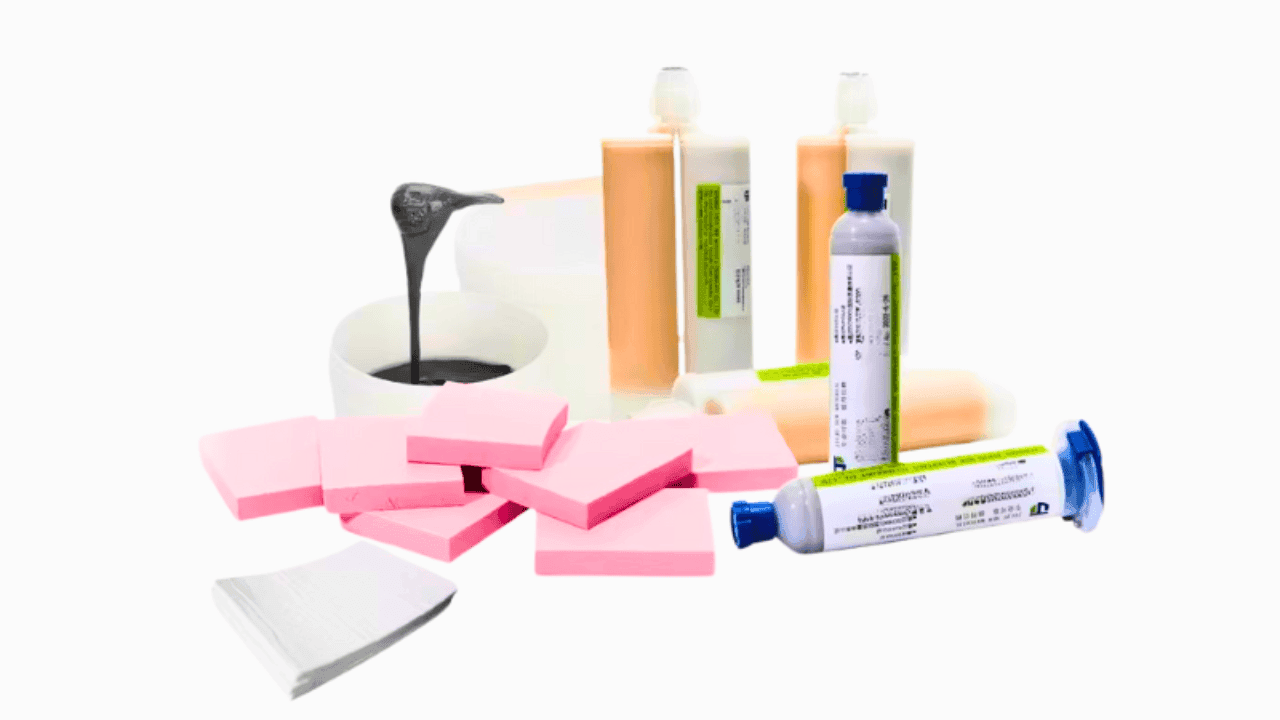Introduction
If we talk about the year 2025 alone, 63% of manufacturers reported 3M/Henkel supply chain delays, which is literally alarming for professional industries. The reason behind it is the global shortage of specialty silicone that’s beyond control even for legacy suppliers like 3M or Henkel.
So how to future-proof your thermal strategy so that you don’t face supply delays in the future? That’s what we’re going to talk about here. Alongside, we’ll have a comparative look at 3M/Henkel thermal pads, gap fillers, silicone gels, and then reveal some disruptive alternatives that can be far better than the old players.
3M & Henkel’s Thermal Material Portfolios
3M and Henkel have been the major players in thermal pads, silicone gels, gap fillers and what not. So here is a brief comparison between 3M 8810 vs Henkel Bergquist gap pad along with Henkel Loctite ABLESTIK vs 3M TC Series.
We’ll also compare them with some nice alternatives that’ll be better than these legacy products.
| Property | 3M 8810 | Henkel GAP PAD TGP 9000 | Emerging Alternative |
|---|---|---|---|
| Thermal Conductivity | 5.0 W/mK | 4.5 W/mK | 7.2 W/mK (Nano-AlN) |
| Vibration Resistance | MIL-STD-810G | IPC-CC-830B | ISO 16750-3 Class 3 |
| Lead Time (2025 Q2) | More than 18 weeks | 14 weeks | 5 weeks |
| Cost per cm² | $0.38 | $0.42 | $0.29 |
Alternatives Outperforming Legacy Brands
Now that the 3M and Henkel supplies appear to be vulnerable, it has given an opening to a lot of alternatives to come up with better and cost-effective alternatives that are driving the market focus from 3M or Henkel to these high-conductivity alternatives to 3M 8810 that also have a Lower cost than Henkel gap pad and 3M.
New Tech Highlight
The innovative advancements have shifted the way thermal pads were being made. Earlier, the thermal pads would use specialty silicone that would provide fair thermal conductivity but now that the electronics sector has advanced, the gadgets are heating more than earlier.
This has triggered the need for a new technology that has a better cooling capacity, and hence alternative brands have developed Boron Nitride-aramid hybrid pads. These special Boron Nitride-aramid hybrid pads have a cooling capacity of 12 W/mK or we can say 0.08mm BLT, which is superior to Henkel and 3M in many aspects.
Case Study
Getting Started: What We Know
- We know that the 3M 8926-250 has a thermal conductivity of 1.5 W/m·K in all 3 directions.
- The thermal impedance ranges from 1.31 to 1.50 °C·in²/W, which we can say, depends on the thickness of the thermal tape.
Case Study
We’re assuming here that we have a drivetrain of 500W power output that has a thermal conductivity of 1.5W/mk.
Case Study
Now we’re taking an objective of reducing the temperature by 22 degrees Celsius, which is possible through alternatives of 3M and Henkel. If we keep the pad thickness of 2mm, then we’ll need about 825W to drop the temperature by 22 degrees Celsius.
A Revolution in Thermal Gap Fillers
Over the last few years, the thermal sector has seen a boom in the advancements, which we’re calling here as thermal gap filler revolution. The purpose and results of this revolution are non-pump-out thermal paste alternatives that have been achieved through fascinating breakthrough formulas. For example:
- Graphene-enhanced thixotropic fillers have been able to give us 8.3 W/mK with Δη<15% @10^4 shear cycles, which is indeed revolutionary.
- Secondly, Silver-glass die-attach substitutes are capable of eliminating the Z-axis CTE mismatch, which is another revolution in the thermal gap fillers and have become Henkel BERGQUIST replacement.
Where 3M/Henkel Are Falling Behind?
There has been a recent development of thermal gap gel that has proved to be better than thermal paste, thermal pads, or gap fillers. This gel is a sort of hybrid technology, that has shown far better results. 3M and Henkel have been failing drastically in keeping up with the ever-changing technology in the thermal and conductivity sector. Here is the test data.
| Test | Henkel ABLESTIK 8360 | AG-7700 |
|---|---|---|
| Thermal Resistance (℃mm²/W) | 0.18 | 0.09 |
| Storage Modulus (MPa) | 0.8 | 0.3 |
| UL 94 Rating | V-1 | V-0 |
We can say that the thermal gels are the next-gen formulas, low-modulus TIM for fragile dies, or halogen-free replacement for Loctite ABLESTIK. For example:
- The self-healing organogels have an estimated ASTM D5 needle penetration of 250-300.
- Similarly, there are electrically insulating silicone gels with 9 W/mK isotropic cooling and the test data is already in the table.
Cost-Benefit Analysis
Hidden Cost Drivers
We have figured out annual price hikes of the supplies by both 3M and Henkel, where 3M stands at a price hike of 8.5% average, while Henkel stood at 6.9%. This is an incredibly high difference as compared to alternative suppliers, who have been locking contracts for 2% price hike every year.
If we talk about the scrap rate, then supply by 3M and Henkel has proved to generate 3.2% scrap, while the alternative suppliers had only 0.7% scrap rate per year.
We suggest that you use ROI widgets like Thermal Material TCO Calculator, and give alternatives a chance to get bulk discount alternatives to Henkel or 3M.
Replacing 3M 8660 in EV Battery Pack Firewalls
This section talks about a case study with the objective of EV battery thermal runaway solution through Nio/Tesla approved alternatives.
Challenge
UL 2596-compliant fire barriers need >1200℃ stability, which should be possible through various thermal solutions.
Solution
The proposed solution is Ceramic-PEEK hybrid pads that offer 1.5x compressive strength of 3M 8660, which gives a strong ground for an argument.
Results
When the proposed solution was tested over the test subject, the following results could have been obtained:
- There was a weight reduction of nearly 40%.
- The proposed solution passed GB 38031 nail penetration test in 95% percentile.
How to Migrate from 3M/Henkel Without Qualification Headaches?
So far it should be clear that there is a strong scope of switching to alternatives, provided that all the test results, case studies, and alternative approvals by Nio and Tesla appear to be far superior than the old players like 3M and Henkel.
Now, the main question arises that how we can switch or migrate from 3M or Henkel without any headaches?
- Conduct CTE mapping
To conduct a CTE mapping, you’ll have to do a ASTM E831 ∆L/L₀ analysis. You also need to study the alternate material approval checklist and the PPAP documentation for TIM change that should be available for a free download.
- Accelerated aging
When choosing an alternative supplier, you shall test their products for stress test, which we denote by accelerated aging (85℃/85% RH, 1000h vs IEC 60068-2-67). To further explain what it means:
- The test conditions will have 85 ° Celsius and 85% relative humidity for nearly 1000 hours.
If the material has the same thermal conductivity before and after the test, it means it’s stable, reliable, and qualifies to be an alternative to 3M and Henkel.
But if the thermal conductivity drops, it means that it has an age-related performance loss.
- Full DFMEA cross-reference
The DFMEA is a tool that can help you figure out any manufacturing defects or design failures before the product is released to the public. AIAG-VDA Alignment is a standard that was rolled out in 2019 that combines the best practises from the Americas and Germany.
When we say cross-reference, it means that your DFMEA includes and fulfills all the steps, terminology, and methodology so that the thermal pad from an alternative supplier that you’re buying is valid for use in your industry.
What 3M/Henkel Aren’t Telling You About 2025 Thermal Materials?
New entrants are dominating the thermal management products market by offering new and better technologies that are not possible with 3M and Henkel yet.
- Biodegradable phase-change materials
The first innovation is the use of biodegradable materials, that can store and release heat but also are capable of breaking down naturally in the environment, which is reducing carbon footprints.
- Metal-organic framework (MOF)-enhanced thermal pastes
New type of thermal pastes are being made of metal ions and organic linkers, that are highly porous and crystalline. This type of thermal pastes give a better thermal conductivity, are lightweight, and give a hybrid performance.
- DLP 3D-printed thermal pads with topology-optimized channels
We can call this type of thermal pad a next generation thermal pad that gives better heat dissipation but the manufacturing requires advances and high-tech machinery, which is easier to manage by the new entrants. This type of pad are also popular across the Nanostructured TIM 2025 and have become among the sustainable electronics adhesives.
Conclusion
It’s clear that the old players like 3M and Henkel are failing somewhere, giving scope to new entrants who are giving better products like Jiujutech. However, that doesn’t mean that 3M or Henkel have lost their edge, they’re just falling back. So, if you’re eager to try a new supplier over 3M or Henkel, you can reach out to Jiujutech for a free sample kit, that also includes ASTM D5470 Test Report.





